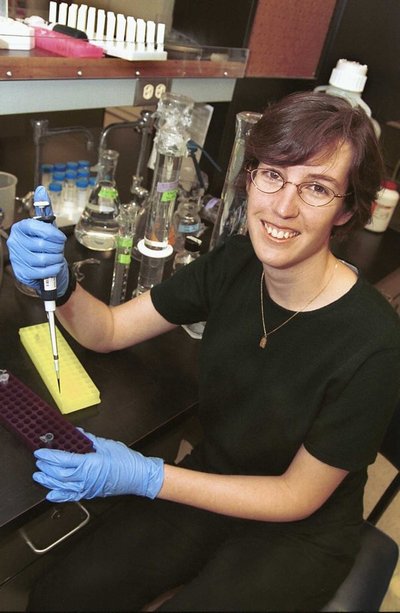August 14, 2003
Genomes of tiny microbes promise insight into oceans, climate change
The world’s smallest photosynthetic organisms, microbes that can turn sunlight and carbon dioxide into living biomass like plants do, are in the limelight this week. Three international teams of scientists announced the genetic blueprints for four closely related forms of these organisms, which numerically dominate the phytoplankton of the oceans.
The work is reported in the August 13 online issues of Nature and the Proceedings of the National Academy of Sciences.
Much like the sequencing of the human genome, the sequencing of the genomes of three strains of Prochlorococcus and one of closely related Synechococcus should crack many mysteries about these organisms – and of phytoplankton in general.
A better understanding of phytoplankton, which plays a critical role in the regulation of atmospheric carbon dioxide, will aid studies on global climate change.
“The four that have been sequenced represent numerous strains that populate ocean waters and form the base of the food web,” said Gabrielle Rocap, a University of Washington assistant professor of oceanography and lead author of the Nature paper reporting the genetic blueprints for two Prochlorococcus strains.
“A hundred of these organisms can fit end-to-end across the width of a human hair,” Rocap said, “but they grow in such abundance that, as small as they are, they at times amount to more than 50 percent of the photosynthetic biomass in the oceans.”
Further, the “metabolic machinery” of these single-celled organisms could serve as a model for sustainable energy production as they can turn sunlight into chemical energy.
“It behooves us to understand exactly how, with roughly 2,000 genes, this tiny cell converts solar energy into living biomass — basic elements into life,” said Sallie “Penny” Chisholm, professor of environmental studies at the Massachusetts Institute of Technology. Rocap earned her doctorate from the MIT-Woods Hole Joint Program in 2000.
“These cells are not just some esoteric little creatures,” she said. “They dominate the oceans. There are some 100 million Prochlorococcus cells per liter of seawater, for example.” Chisholm was part of the team that first described Prochlorococcus in 1988.
In the same issue of Nature, a team led by Brian Palenik of the Scripps Institution of Oceanography, University of California-San Diego, reported the sequence of Synechococcus, a co-inhabitant of ocean waters with Prochlorococcus, that has a unique form of motility. Another paper, written by a team led by Frederick Partensky, Centre National de la Recherche Scientifique, Station Biologique de Roscoff, describes the genome of a third strain of Prochlorococcus and was published in the Proceedings of the National Academy of Sciences.
The paper with Rocap as lead author reports the genetic sequences for two different Prochlorococcus strains, then goes on to compare the two. The resulting analysis reveals many of the genetic foundations for the observed differences in the two’s physiologies and vertical niche partitioning, that is their differences that allow them to thrive at different depths in the ocean’s surface waters.
“The idea is to let the organisms tell us what dimensions of their environment are important in determining their distribution and abundance,” Chisholm said. “And this will become easier and easier as the genomes of additional strains are sequenced, and the functions of the genes are understood.”
Rocap said, “Right now we don’t even know the range of diversity that exists. We’ve just had a glimpse of the different genome types that are out there.”
Other authors of the Rocap paper include Nathan Ahlgren, a UW graduate student in oceanography, additional authors from MIT, and from Oak Ridge National Laboratory, the Joint Genome Institute, Lawrence Livermore National Laboratory, Humboldt University in Germany, Interuniversity Institute of Marine Science in Israel and Woods Hole Oceanographic Institution.
The research was sponsored by the U.S. Department of Energy, National Science Foundation Seaver Foundation, Israel-U.S. Binational Science Foundation and FP5-Margenes.
Raymond Orbach, director of the Department of Energy’s Office of Science, said, “While many questions remain, it’s clear that Prochlorococcus and Synechococcus play an immensely significant role in photosynthetic ocean carbon sequestration. Having the completed genome in hand gives us a first–albeit crude–‘parts list’ to use in exploring the mechanisms for these and other important processes that could be directly relevant to this critical DOE mission.”
“This research addresses in a concrete way major questions in biological oceanography, at levels finer than the species level,” said Phil Taylor, director of NSF’s biological oceanography program, which also funded part of the research. “The work shows there is a rich and fascinating diversity of physiological capacity and adaptation in the sea, and that this diversity is not always revealed by looking in the microscope.”
###
For more information:
Rocap, 206-685-9994, rocap@ocean.washington.edu
http://faculty.washington.edu/rocap/
— Elizabeth Thomson, MIT News Office, 617-258-5402, thomson@mit.edu
— Mario Aguilera, Scripps News Office, 858-534-3624, scrippsnews@ucsd.edu
— Cheryl Dybas, NSF News Office, 703-292-7734, cdybas@nsf.gov
— Charles Osolin, Lawrence Livermore National Laboratory News Office, 925-296-5643, osolin1@llnl.gov



